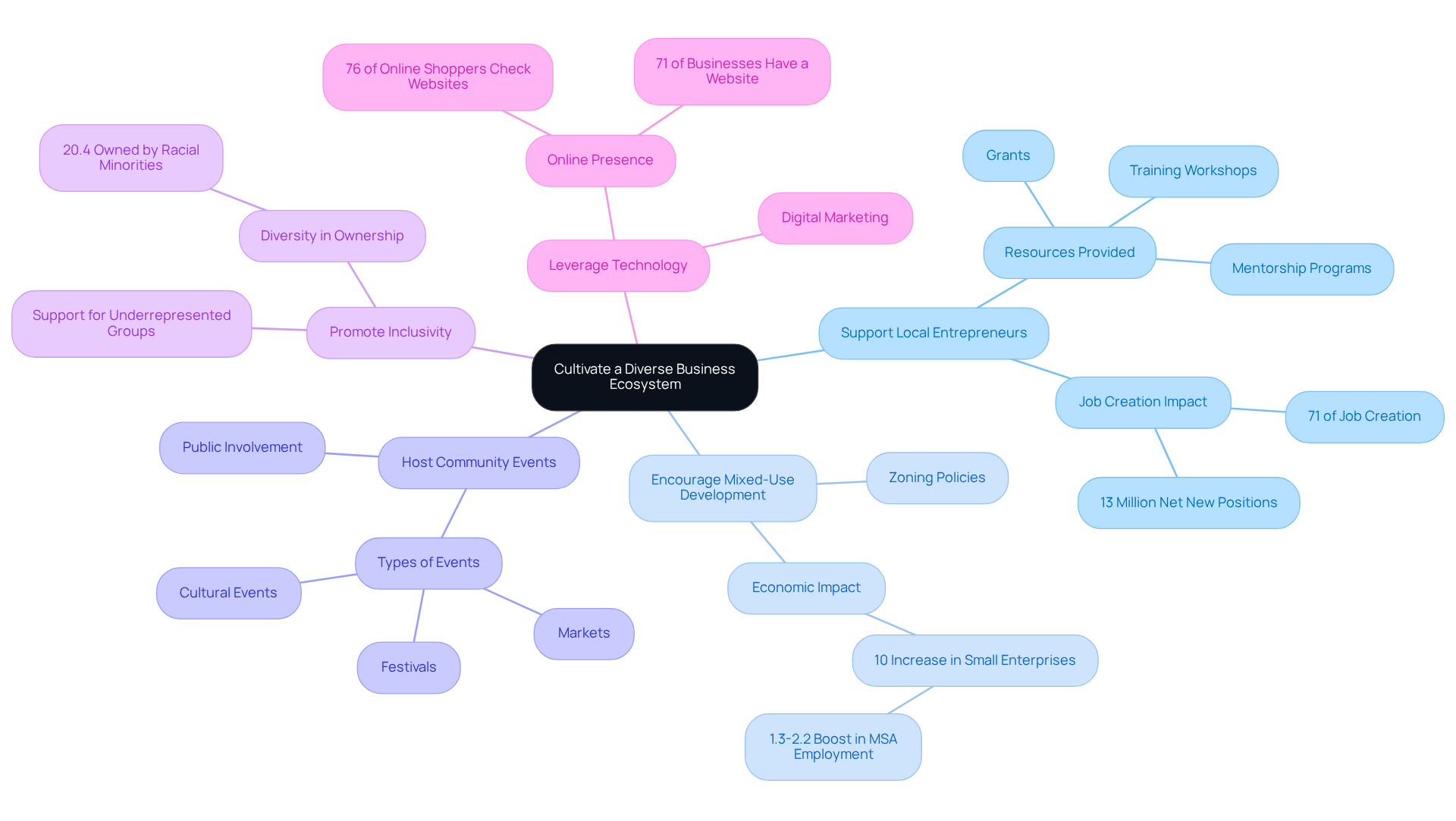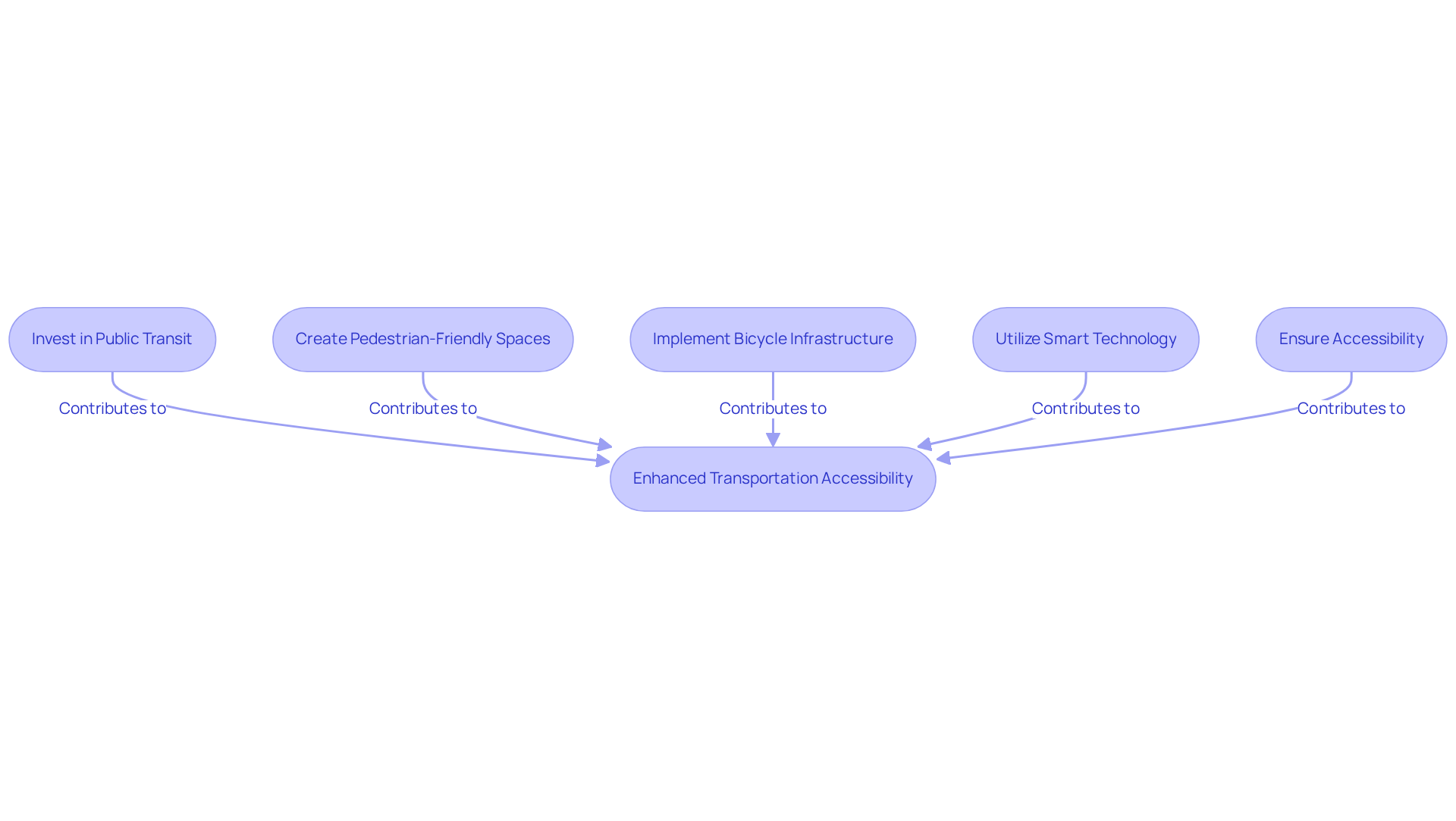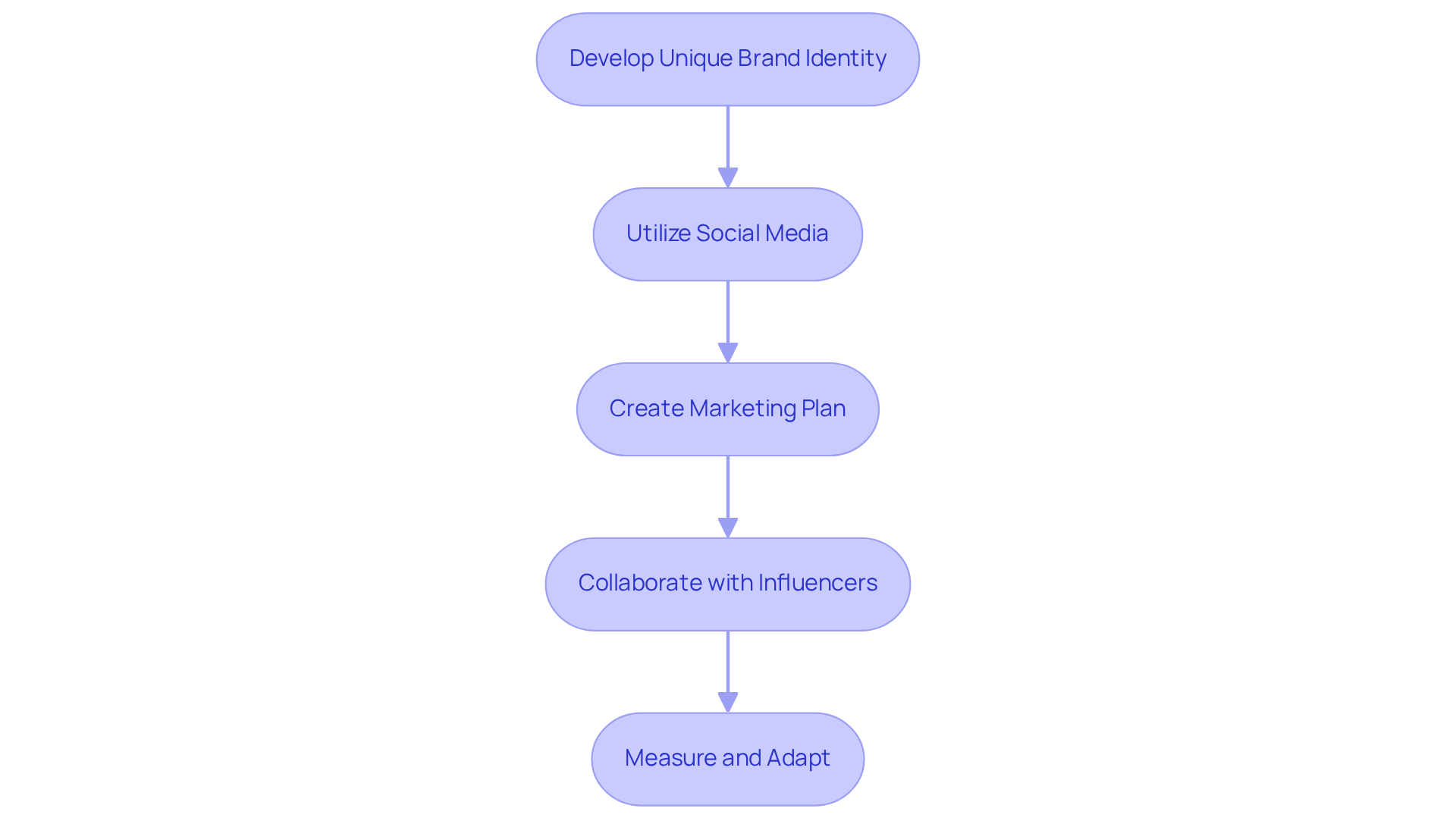Overview
The article delineates four pivotal strategies for cultivating a vibrant downtown Central Business District:
- Strategic planning and community engagement
- Fostering a diverse business ecosystem
- Enhancing infrastructure and transportation accessibility
- Executing effective marketing and branding strategies
Each approach underscores the significance of community involvement, inclusivity, and sustainable practices. Supported by data and real-world examples, these strategies illustrate their potential to revitalize urban areas and stimulate economic growth. By prioritizing these elements, stakeholders can effectively contribute to the transformation of their communities.
Introduction
Revitalizing a downtown central business district (CBD) transcends mere aesthetics; it embodies a complex interplay of strategic planning, community engagement, and innovative marketing. As urban areas confront the dual challenges of economic pressures and shifting consumer behaviors, the necessity for a thriving CBD has reached critical levels. This article delves into four pivotal strategies capable of transforming underperforming districts into vibrant hubs of activity. We will focus on:
- Community involvement
- Diverse business ecosystems
- Enhanced infrastructure
- Effective branding
How can cities harness these strategies not only to attract visitors but also to cultivate long-term sustainability and growth?
Establish Strategic Planning and Community Engagement
To establish effective strategic planning and community engagement, consider the following steps:
-
Conduct a Needs Assessment: Utilize surveys, focus groups, and public meetings to gather data on local needs and preferences. It is crucial to recognize that 80% of the district's children under the age of 18 are food insecure, underscoring the importance of needs assessments in urban planning. This foundational step ensures that the planning process is informed by the voices of residents, which is vital for successful outcomes.
-
Create a Vision Statement: Collaborate with stakeholders to formulate a clear vision for the downtown area that captures the aspirations of the residents. A well-defined vision serves as a guiding star for all subsequent planning efforts.
-
Create a Strategic Plan: Outline specific goals, objectives, and action steps derived from the needs assessment and vision statement. Flexibility is essential; the plan should be adjustable to changing situations and public input.
-
Engage the Public: Utilize diverse platforms, including social media, town halls, and newsletters, to keep the public informed and actively involved in the planning process. As Shira Daskal observed, "As municipal authorities encounter constricting budgets and increasing resident expectations, the manner in which you involve your population has never been more significant." Frequent updates and feedback loops promote transparency and trust, enhancing group buy-in.
-
Establish Collaborations: Work together with local enterprises, non-profits, and government organizations to combine resources and knowledge. This comprehensive approach not only strengthens the revitalization efforts but also ensures that diverse perspectives are integrated into the planning process. For example, the City of Chattanooga successfully created a resident-informed budget of $317 million, demonstrating the effective application of community engagement and needs assessments in real-world scenarios.

Cultivate a Diverse Business Ecosystem
To cultivate a diverse business ecosystem in the downtown central business district, it is essential to implement strategic initiatives that can drive growth and sustainability.
- Support Local Entrepreneurs: Providing resources such as grants, mentorship programs, and training workshops is crucial for empowering local entrepreneurs in starting and growing their ventures. This assistance is vital, as small enterprises represent roughly 71% of overall job creation in the current economic cycle, producing almost 13 million net new positions over the last 25 years.
- Encourage Mixed-Use Development: Advocating for zoning policies that facilitate a blend of residential, commercial, and recreational spaces is key. Mixed-use developments not only enhance the vibrancy of urban areas but also attract a diverse range of enterprises, contributing to a more dynamic downtown central business district. Successful projects demonstrate that such developments can lead to increased foot traffic and higher sales for nearby businesses. Notably, a 10% rise in the establishment of small enterprises can yield a 1.3-2.2% boost in MSA employment, underscoring the beneficial impact of mixed-use developments on regional economies.
- Host Community Events: Organizing markets, festivals, and cultural events that showcase local enterprises is another effective strategy. These events foster public involvement and encourage spending, creating a vibrant environment that benefits all businesses in the region.
- Promote Inclusivity: Ensuring that support programs are accessible to underrepresented groups fosters a more inclusive environment that reflects the community's diversity. This approach not only enhances social equity but also taps into a broader array of entrepreneurial talent, which is crucial for a thriving economic ecosystem. Currently, 20.4% of small enterprises are owned by racial minorities, highlighting the importance of supporting these groups.
- Leverage Technology: Utilizing online platforms to promote community enterprises enables them to reach a wider audience and compete effectively in the digital marketplace. With 76% of online shoppers reviewing a company's website before visiting, establishing a robust online presence is essential for attracting customers and boosting sales. Furthermore, 71% of companies have a website, emphasizing the necessity for local enterprises to cultivate a digital footprint.
By implementing these strategies, the downtown central business district can create a robust and diverse business ecosystem that not only supports growth but also ensures long-term sustainability.

Enhance Infrastructure and Transportation Accessibility
To enhance infrastructure and transportation accessibility, consider implementing the following practices:
- Investing in public transit is essential for linking adjacent neighborhoods with the downtown central business district through enhanced transportation choices. A significant 73% of Americans believe that high-quality national transportation systems are important to economic prosperity and quality of life, according to HNTB. This accessibility not only facilitates easier access for residents and visitors in the downtown central business district but also encourages increased foot traffic in that area.
- Create Pedestrian-Friendly Spaces: Designing streetscapes that prioritize pedestrians is crucial. Attributes such as broader sidewalks, clearly defined crosswalks, and welcoming seating spaces can greatly improve the pedestrian experience, rendering urban areas more appealing and reachable. Notably, public transportation produces 95% less carbon monoxide, 90% less volatile organic compounds, and about 50% as much carbon dioxide and nitrogen oxide per mile compared to private vehicles, underscoring the environmental benefits of pedestrian-friendly designs.
- Implement Bicycle Infrastructure: Developing dedicated bike lanes and secure bike parking encourages cycling as a viable transportation option. This caters to environmentally conscious consumers and promotes a healthier lifestyle, contributing to a vibrant urban atmosphere. The economic impact is notable; a $10 million investment in public transportation can result in a $30 million gain in sales for local businesses.
- Utilize Smart Technology: Incorporating smart city technologies can significantly improve traffic management and provide real-time information on public transit options. This enhances the user experience, making it easier for individuals to navigate the urban landscape efficiently. For instance, the deployment of online trip planning for Glasgow Transit using GTFS Builder demonstrates how technology can improve accessibility and user engagement.
- Ensure Accessibility: It is vital to design infrastructure that accommodates individuals with disabilities. By ensuring that all community members can access city areas comfortably, cities can foster inclusivity and enhance the overall quality of life for residents and visitors alike.

Implement Effective Marketing and Branding Strategies
To implement effective marketing and branding strategies for a thriving downtown Central Business District, consider the following steps:
-
Develop a Unique Brand Identity: Craft a distinctive brand that embodies the character and values of the downtown area. This involves creating a memorable logo and tagline that connect with the local audience. Consistent brand presentation across all platforms can increase revenue by up to 10-20%, making it essential to maintain a cohesive brand image.
-
Utilize Social Media: Use social media platforms to encourage engagement within the group, promote nearby events, and highlight enterprises. A vibrant online presence can significantly enhance visibility, as 55% of consumers prefer brands that interact with them directly on these platforms. As Macy states, "In a world filled with noise and conflicting messages, authenticity stands out like a beacon," highlighting the importance of genuine engagement.
-
Create a Marketing Plan: Formulate a comprehensive marketing plan that identifies target audiences, key messages, and promotional tactics. This organized method can assist in drawing visitors and businesses, ensuring that marketing initiatives are aligned with local interests.
-
Collaborate with Nearby Influencers: Partner with nearby influencers and community leaders to amplify marketing initiatives. Engaging these figures can broaden outreach and enhance credibility, as their endorsements often resonate well with local audiences.
-
Measure and Adapt: Regularly assess the efficacy of marketing strategies using metrics such as foot traffic, social media engagement, and company growth. This ongoing assessment allows for timely adjustments, ensuring that marketing efforts remain relevant and effective in driving community engagement. For instance, research by Sprout Social indicates that 77% of consumers are more likely to purchase from brands that evoke a strong emotional bond, underscoring the impact of emotional connections in branding.
By implementing these strategies, the downtown central business district can enhance its marketing efforts and foster a thriving business environment.

Conclusion
Creating a thriving downtown central business district necessitates a multifaceted approach that integrates strategic planning, community engagement, and a diverse business ecosystem. By prioritizing the needs and aspirations of residents, cities can develop actionable plans that enhance local economies and foster a sense of belonging and community pride. Engaging stakeholders throughout the planning process ensures that initiatives reflect the community's desires, paving the way for sustainable growth.
Key strategies include:
- Cultivating a diverse business environment by supporting local entrepreneurs.
- Promoting mixed-use developments.
- Leveraging technology for marketing and accessibility.
- Investing in infrastructure improvements and transportation accessibility.
These elements directly impact foot traffic and overall business success. Furthermore, effective branding and marketing strategies can elevate the visibility of downtown areas, drawing in visitors and potential customers.
Ultimately, the success of a downtown central business district hinges on collaboration and inclusivity. By embracing the diverse voices within the community and implementing innovative strategies, cities can create vibrant urban spaces that thrive economically and enrich the lives of their residents. The time to act is now; fostering a robust downtown environment is not just beneficial for businesses but essential for the holistic development of urban communities.




